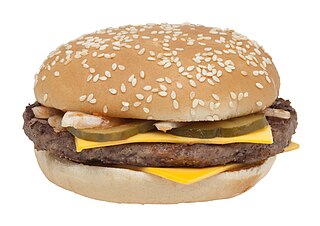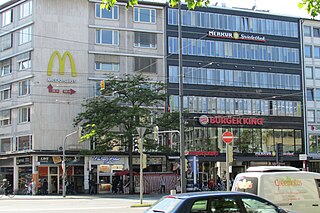
A hamburger, or simply burger, is a sandwich consisting of fillings—usually a patty of ground meat, typically beef—placed inside a sliced bun or bread roll. Hamburgers are often served with cheese, lettuce, tomato, onion, pickles, bacon, or chilis; condiments such as ketchup, mustard, mayonnaise, relish, or a "special sauce", often a variation of Thousand Island dressing; and are frequently placed on sesame seed buns. A hamburger patty topped with cheese is called a cheeseburger.

A fast-food restaurant, also known as a quick-service restaurant (QSR) within the industry, is a specific type of restaurant that serves fast-food cuisine and has minimal table service. The food served in fast-food restaurants is typically part of a "meat-sweet diet", offered from a limited menu, cooked in bulk in advance and kept hot, finished and packaged to order, and usually available for take away, though seating may be provided. Fast-food restaurants are typically part of a restaurant chain or franchise operation that provides standardized ingredients and/or partially prepared foods and supplies to each restaurant through controlled supply channels. The term "fast food" was recognized in a dictionary by Merriam–Webster in 1951.

Burger King Corporation (BK), known as Hungry Jack's in Australia, is an American-based multinational chain of hamburger fast food restaurants. Headquartered in Miami-Dade County, Florida, the company was founded in 1953 as Insta-Burger King, a Jacksonville, Florida–based restaurant chain. After Insta-Burger King ran into financial difficulties, its two Miami-based franchisees David Edgerton (1927–2018) and James McLamore (1926–1996) purchased the company in 1959 and renamed it "Burger King". Over the next half-century, the company changed hands four times and its third set of owners, a partnership of TPG Capital, Bain Capital, and Goldman Sachs Capital Partners, took it public in 2002. In late 2010, 3G Capital of Brazil acquired a majority stake in the company, in a deal valued at US$3.26 billion. The new owners promptly initiated a restructuring of the company to reverse its fortunes. 3G, along with partner Berkshire Hathaway, eventually merged the company with the Canadian-based doughnut chain Tim Hortons, under the auspices of a new Canadian-based parent company named Restaurant Brands International.

Hardee's Restaurants LLC is an American fast-food restaurant chain operated by CKE Restaurants Holdings, Inc. ("CKE") with locations primarily in the Southern and Midwestern United States. The company has evolved through several corporate ownerships since its establishment in 1961 in North Carolina.

Raymond Albert Kroc was an American businessman. He purchased the fast food company McDonald's in 1961 from the McDonald brothers and was its CEO from 1967 to 1973. Kroc is credited with the global expansion of McDonald's, turning it into the most successful fast food corporation in the world by revenue.

The Big Mac is a hamburger sold by the international fast food restaurant chain McDonald's. It was introduced in the Greater Pittsburgh area in 1967 and across the United States in 1968. It is one of the company's flagship products and signature dishes. The Big Mac contains two beef patties, cheese, shredded lettuce, pickles, minced onions, and a Thousand Island-type dressing advertised as "special sauce", on a three-slice sesame-seed bun.

In-N-Out Burger is an American regional chain of fast food restaurants with locations primarily in California and to a lesser extent the Southwest from Oregon to Texas. It was founded in Baldwin Park, California, in 1948 by Harry (1913–1976) and Esther Snyder (1920–2006). The chain is currently headquartered in Irvine, California and has expanded outside Southern California into the rest of California, as well as into Arizona, Nevada, Utah, Texas, Oregon, and Colorado, and is planning expansions into Idaho and Tennessee. The current owner is Lynsi Snyder, the Snyders' only grandchild.

Burger Chef was an American fast-food restaurant chain. It began operating in 1954 in Indianapolis, Indiana, expanded throughout the United States, and at its peak in 1973 had 1,050 locations, including some in Canada. The chain featured several signature items, such as the Big Shef and Super Shef hamburgers.

The Red Barn restaurant was a fast-food restaurant chain founded in 1961 in Springfield, Ohio, by Don Six, Martin Levine, and Jim Kirst. In 1963, the small chain was purchased by Richard O. Kearns, operated as Red Barn System, with the offices moving briefly to Dayton, Ohio and in August 1964 to Fort Lauderdale, Florida. During the late 1960s United Servomation, also called Servomation, bought the Red Barn chain. In 1978 United Servomation merged with the City Investing Company's GDV division which also owned the Motel 6 motel chain. Only interested in real estate, construction, and financial services the new owners ceased advertising for the chain along with allowing the franchise leases to expire with the last of the leases expiring around 1988. At its peak, Red Barn had 300–400 restaurants in 19 states, as well as outlets in southern Ontario, elsewhere in Canada, and Australia.
Richard James McDonald and Maurice James McDonald, together known as the McDonald Brothers, were American entrepreneurs who founded the fast food company McDonald's. They opened the original McDonald's restaurant in 1940 in San Bernardino, California, where they created the Speedee Service System to produce their meals, a method that became the standard for fast food. After hiring Ray Kroc as their franchise agent in 1954, they continued to run the company until they were bought out by Kroc in 1961.

The Quarter Pounder is a hamburger sold by international fast food chain McDonald's, so named for containing a patty with a precooked weight of 4 oz, a quarter of a pound (113.4 g). It was introduced in 1971. In 2013, the Quarter Pounder was expanded to represent a whole line of hamburgers that replaced the company's discontinued Angus hamburger. In 2015, McDonald's increased the precooked weight to 4.25 oz (120 g).

McDonald's Corporation is an American multinational fast food chain, founded in 1940 as a restaurant operated by Richard and Maurice McDonald, in San Bernardino, California, United States. They rechristened their business as a hamburger stand, and later turned the company into a franchise, with the Golden Arches logo being introduced in 1953 at a location in Phoenix, Arizona. In 1955, Ray Kroc, a businessman, joined the company as a franchise agent and proceeded to purchase the chain from the McDonald brothers. McDonald's previous headquarters was based in Oak Brook, Illinois, but the company moved its global headquarters to Chicago in June 2018. McDonald's is also a real estate company through its ownership of around 70% of restaurant buildings and 45% of the underlying land.

White Tower Hamburgers was a fast food restaurant chain that was founded in 1926 in Milwaukee, Wisconsin. With its similar white fortress-like buildings and menu it is considered to be an imitator of White Castle chain that was founded in 1921. The chain was successful and expanded to other cities, including Chicago, Indianapolis, Cleveland, Dayton, Detroit, Philadelphia, Pittsburgh, Baltimore, New York City, Albany, Boston, Richmond, Virginia, and as far south as Sarasota, Florida. During the Great Depression, White Tower sold hamburgers for five cents. The whiteness of the restaurant was meant among other things to evoke the notion of hygienic conditions, and the chain had staff dressed as nurses, dubbed the "Towerettes," to help make this argument.

The Big King sandwich is one of the major hamburger products sold by the international fast-food restaurant chain Burger King, and was part of its menu for more than twenty years. As of March 2019, it is sold in the United States under its 1997 Big King XL formulation. During its testing phase in 1996–1997, it was originally called the Double Supreme and was configured similarly to the McDonald's Big Mac—including a three-piece roll. It was later reformulated as a more standard double burger during the latter part of product testing in 1997. It was given its current name when the product was formally introduced in September 1997, but maintained the more conventional double cheeseburger format.

The BK Stacker sandwiches are a family of cheeseburgers sold by the international fast-food restaurant chain Burger King.
Juan Pollo is a Mexican-style rotisserie chicken restaurant chain headquartered in San Bernardino, California founded in 1984 by Albert Okura. Its restaurants are located mostly in the Inland Empire region of Southern California, with other locations in Riverside, San Bernardino and Orange counties.

The Burger wars are a series of off-and-on comparative advertising campaigns consisting of mutually-targeted advertisements that highlight the intense competition between hamburger fast food chains McDonald's, Wendy's, Burger King and others in the United States. The term first came into use during the late 1970s due to an attempt by Burger King to generate increased market and mind-share by attacking the size of bigger rival McDonald's hamburgers.

The United States was the first country where two slices of bread and a ground beef patty were combined into a "hamburger sandwich" and sold. Shortly after its creation, the hamburger quickly included all of its currently typically characteristic trimmings, including onions, lettuce, and sliced pickles.

Henry's Hamburgers is a former American fast-food restaurant chain of the 1950s, 1960s, and 1970s. Only one franchise store, in Michigan, remains.

















